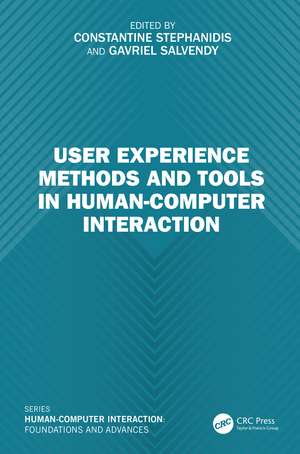User Experience Methods and Tools in Human-Computer Interaction
Editat de Constantine Stephanidis, Gavriel Salvendyen Limba Engleză Hardback – 12 aug 2024
This book
- Provides methods and tools tailored for each stage of the design process
- Discusses methods for the active involvement of users in the human‑centered design process
- Equips readers with an effective toolset for use throughout the design process, ensuring that what is created aligns with user needs and desires
- Covers a wide array of research and evaluation methods employed in HCI, from the initiation of the human‑centered development cycle to its culmination
Preț: 1130.33 lei
Preț vechi: 1378.45 lei
-18% Nou
Puncte Express: 1695
Preț estimativ în valută:
216.31€ • 224.46$ • 180.80£
216.31€ • 224.46$ • 180.80£
Carte tipărită la comandă
Livrare economică 17-31 martie
Preluare comenzi: 021 569.72.76
Specificații
ISBN-13: 9781032370026
ISBN-10: 1032370025
Pagini: 488
Ilustrații: 182
Dimensiuni: 178 x 254 mm
Greutate: 1.06 kg
Ediția:1
Editura: CRC Press
Colecția CRC Press
Locul publicării:Boca Raton, United States
ISBN-10: 1032370025
Pagini: 488
Ilustrații: 182
Dimensiuni: 178 x 254 mm
Greutate: 1.06 kg
Ediția:1
Editura: CRC Press
Colecția CRC Press
Locul publicării:Boca Raton, United States
Public țintă
Postgraduate and Undergraduate AdvancedCuprins
1. Requirements Engineering and User Needs Analysis. 2. Ethnography, User Observation and Interviews. 3. Ideation, Focus Groups and Brainstorming. 4. Personas, Scenarios, Journey Maps and Storyboarding. 5. Task Analysis and Modeling. 6. Designing and Analyzing Questionnaires and Surveys. 7. Inspection Methods for Usability Evaluation. 8. Designing, Conducting, Analyzing and Reporting Usability Testing Experiments. 9. Eye-Tracking and Physiological Measurements for UX Evaluation. 10. Participatory Design. 11. Crowdsourcing in UX research. 12. Responsible User Modeling. 13. Digital Human Modeling. 14. Prototyping Techniques for UX Research. 15. UX Design Tools. 16. Gamification Design. 17. Help and User Support.
Notă biografică
Constantine Stephanidis is Professor at the Department of Computer Science of the University of Crete, past Director of the Institute of Computer Science of FORTH and Founding Head of its Human-Computer Interaction (HCI) Laboratory and its Ambient Intelligence Program. He has been the Principal Investigator for over 180 European Commission, National and Industry funded projects. He is the founding editor of the International Journal Universal Access in the Information Society, co-editor of the International Journal of Human-Computer Interaction and General Chair of the HCI International Conference. He is the President of the Council for Research and Innovation of the Region of Crete and the President of the Hellenic National Accessibility Authority.
Gavriel Salvendy is University Distinguished Professor at the College of Engineering and Computer Science at the University of Central Florida and Founding President of the Academy of Science, Engineering, and Medicine of Florida. He is Professor Emeritus of Industrial Engineering at Purdue University and Chair Professor Emeritus and Founding Head of the Department of Industrial Engineering at Tsinghua University, Beijing, P.R. China. He is a member of the National Academy of Engineering and the recipient of the John Fritz Medal, which is frequently referred to as the Nobel Prize in Engineering. He is the Founding Editor of the International Journal of Human-Computer Interaction and the Founder of the International Conference on Human-Computer Interaction – now in its 40th year.
Gavriel Salvendy is University Distinguished Professor at the College of Engineering and Computer Science at the University of Central Florida and Founding President of the Academy of Science, Engineering, and Medicine of Florida. He is Professor Emeritus of Industrial Engineering at Purdue University and Chair Professor Emeritus and Founding Head of the Department of Industrial Engineering at Tsinghua University, Beijing, P.R. China. He is a member of the National Academy of Engineering and the recipient of the John Fritz Medal, which is frequently referred to as the Nobel Prize in Engineering. He is the Founding Editor of the International Journal of Human-Computer Interaction and the Founder of the International Conference on Human-Computer Interaction – now in its 40th year.
Descriere
The text presents methods and tools to analyze and report the findings of user research and evaluation in a manner that is helpful and precise across departments. It will serve as an ideal text for students, professionals, and researchers in the fields of ergonomics, human factors, human-computer interaction, and computer engineering.
